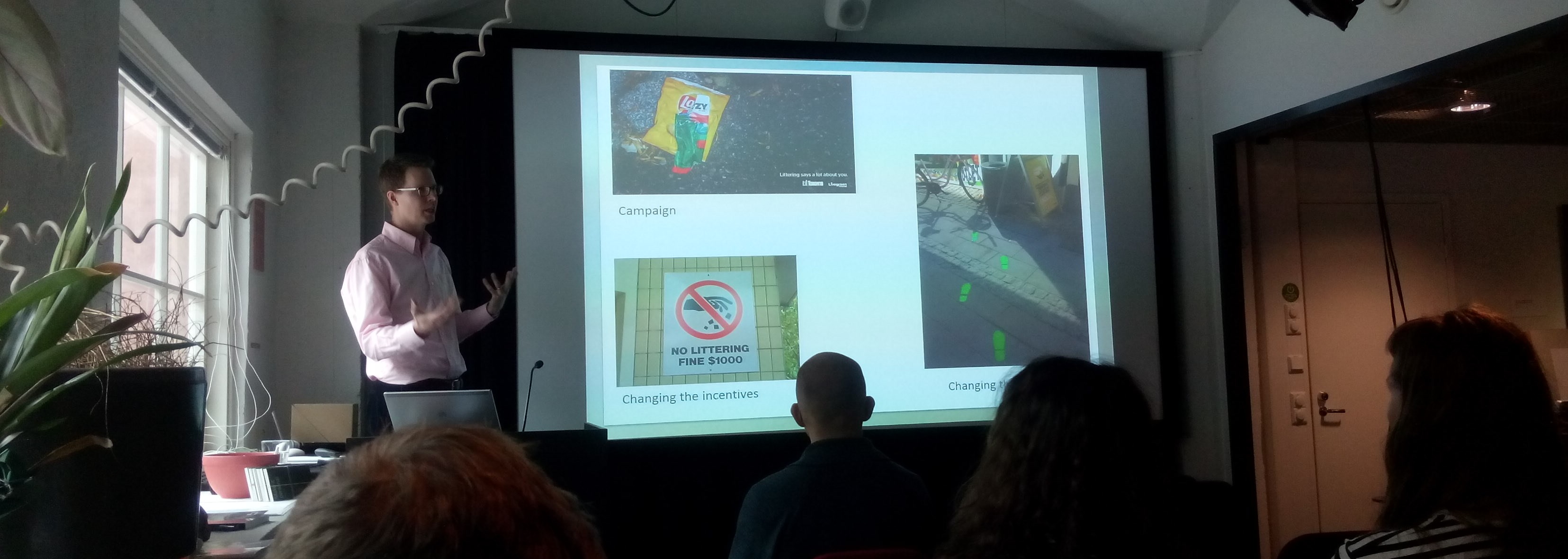Editor’s note: We offered this blog as a platform to the DfG course participants who are documenting the DfG course for the readers to get a glimpse of how things went. This is one such post by Project Piazza team 2.
The previous post dived deeper into systems thinking and the creation of systems models. Based on this we finalised the Systems Block week by presenting our systems maps, on which we received valuable feedback from the DfG tutors. Since then, we have moved on to the Behavioural Block, during which we have learned more about behavioural insights and nudging.
What are we working on? And what have we been doing during the past 8 weeks?
We are Team number 2 working on the Project Piazza, commissioned by the Prime Minister’s Office. The goal of is to co-create a service (e.g. a digital platform), that connects the producers of research including researchers in public R&D projects, research institutions and the beneficiaries of it such as committees, civil servants, policy makers, research funders, and general public in order to improve research impact and optimise evidence-based decision-making.
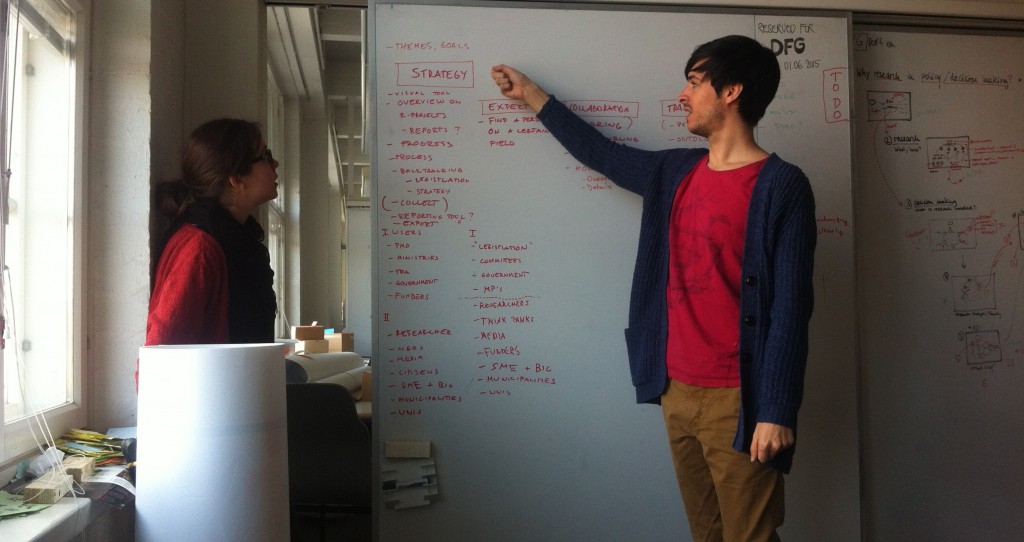
During the past 8 weeks, we have done a lot of research – we read many reports and interviewed over 20 stakeholders with different roles and positions around the usage of research in policy making.
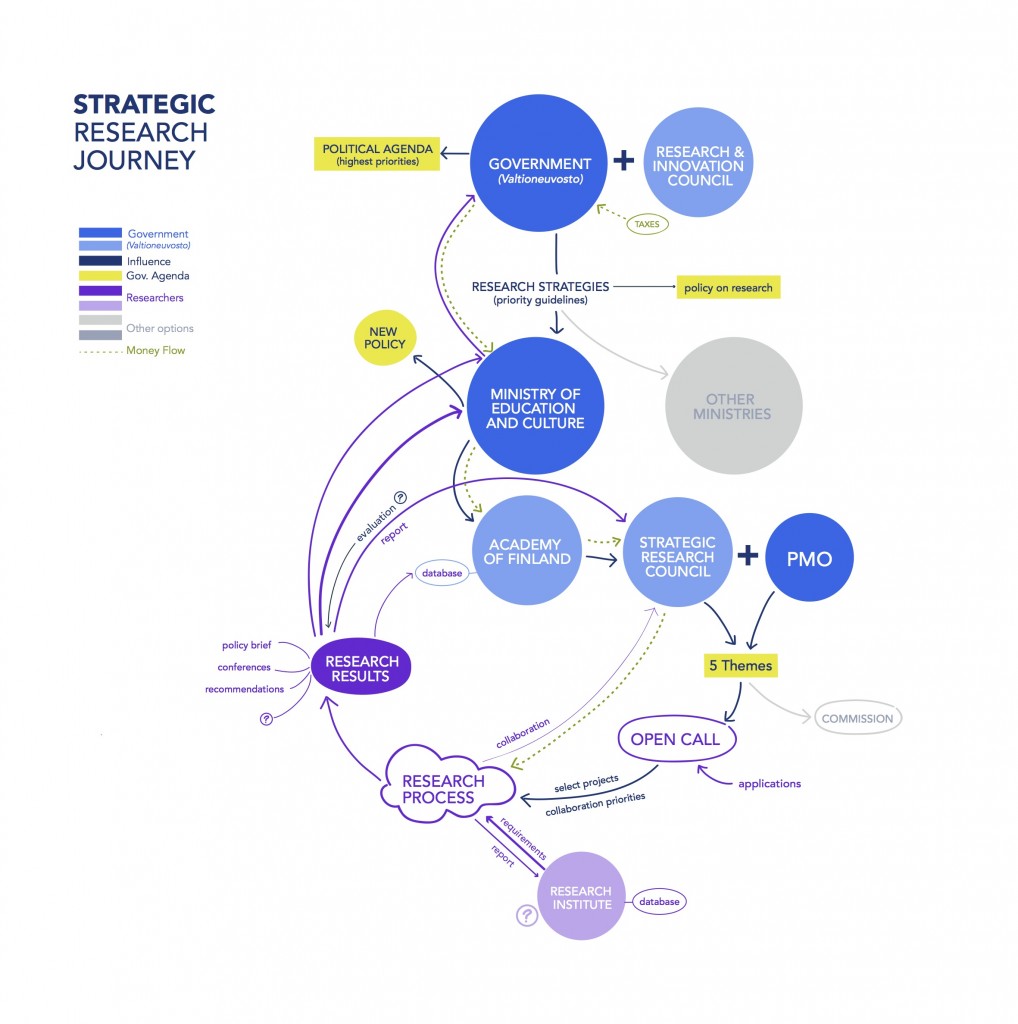
Behavior Block: What is behavioural insight and nudging?
Economist use the term homo economicus to describe a person who always makes rational decisions. But, as we all know, humans in real life do not act solely rationally. When making decisions, we are confronted with limited information and cognitive biases, and we are influenced by emotions and social relationships than reasoning. So, we are actually not the rational and fact-based beings lots of services are designed for. That’s also why our lecturer Markus Kanerva from the Think Tank Tänk stated, that policy-makers should think about their users in more realistic set-ups and design appropriate services for them!
We have two systems in our brain – 1. automatic and fast system 2. reflective and effortful system. Our brain tries to simplify decisions by recognising patterns in the past memories in order to save energy. Reflecting takes effort, and our brain tries to avoid it as much as possible, which is why we pull the door when it needs to pushed. It’s not our fault, it’s design problem, as Don Norman aptly pointed out in the Design of Everyday Things. Any artefact has affordance which triggers certain behaviour whether it’s a door knob or a policy.
The good news is that it is possible to design for irrational behaviour and give people a gentle push, or so-called “nudge”, for the preferred result. Don’t get it wrong – simply imposing a fine is not a nudge. Nudges are subtle and they help make a better decision more easily while neither hindering a person from choosing between various alternatives nor pushing him or her choose the non-desirable option. A nudge is hereby defined as any small feature that attracts our attention and influences our behaviour from the environmental level to policy level.
A small thing can have a huge impact on our behaviour. In a study by Cornell and NY Times, the relocation of a salad table in a canteen tripled the salad sales while the use of glass bowls doubled the fruit sales. Another – perhaps a bit more nasty – example from Schiphol Airport’s men’s room described how an image of a fly attached to the urinals led to a significant 80 % decrease in spillage. In general the simplest, but at the same time also most sticky and therefore very powerful nudge, is the default setting. Given that most of the people usually don’t change default settings (e.g. mobile phone ringtones, organ donation) they are a simple, but weighty aspect of influencing behaviour. So, for example, what should be the default?
Concerns about the concept of nudge?
Questions related to misuse of nudge, like “who has the right to nudge?” created vivid discussions in the classroom. One of the main arguments – not only in our class but in academic literature and news articles – is that to “nudge” people into one direction, is to assume what is best for people and what people want, and especially when it’s done by corporations or governments, the nudge will follow the institution’s agenda – paternalism.
However, the leading figures of behavioural insight are very clear on this issue, and answers this question: it is important to acknowledge that there is no way to design neutral architecture of choices. Someone has always designed the order of options so that it has an effect on the behaviour of the ones making the choice.
In their book “Nudge”, Thaler and Sunstein also emphasise that they “strive to design policies that maintain or increase freedom of choice (p.16)”. “Choice architects” aim to make the default choice a better one, but people who want to make an active choice have the freedom to choose from all alternatives. To sum up, the way in which a choice is structured and when, where and how they are placed matter, and therefore our task in DfG is to make informed design decisions to help good decisions for the people.
Behavioural economics lecture by Markus Kanerva (Tänk)
Markus gave us a general introduction to the world of behavioural insights and nudging and the way they apply it at TÄNK to real world problems and public policy. One of the statements he made was that although informing and educating people is fundamental and great if it works, sometimes – especially when we talk about automatic and fast thinking – one should apply another approach.
Instead of trying to change behaviour by changing cognition such as beliefs or attitudes one can change behaviour by changing the context and affect people’s behaviour without limiting them from doing something else. This approach is again what we defined previously as nudging. As a practical tool for influencing behavior he introduced 9 basic behaviour insight principles that should be considered while creating nudges. You can find these MINDSPACE principles here.
As part of Markus’ lecture we were given an (impossible) task of creating a nudge that would decrease alcohol consumption in Finland. We started by identifying the problem and mapping behaviour related to the problem. After that we moved on to ideating ways of affecting the behaviour. It was quite challenging to identify suitable nudges for the case and many solutions ended up being related to imposing laws or regulations that would change behaviour.
The exercise demonstrated that even though nudges often seem very simple and straight-forward it requires a lot of work to understand behaviour models of people in order to create a suitable nudge, and we are happy that we’ve done our homework over the past weeks for our own project.
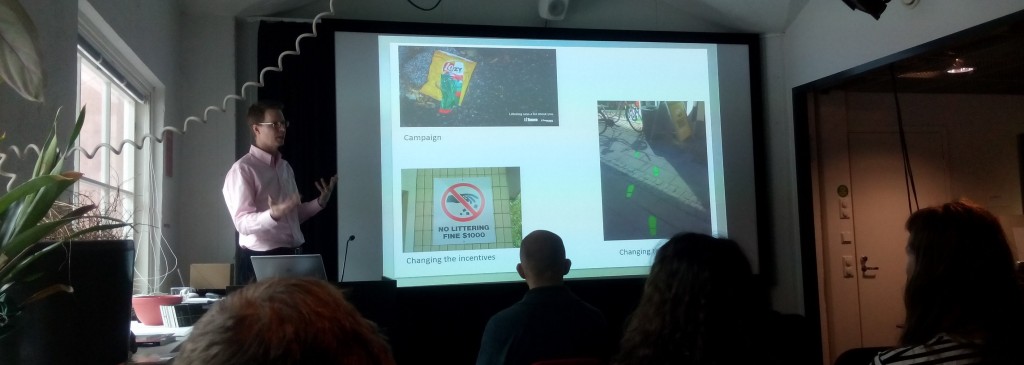
Working in Think Tank, lecture by Outi Kuittinen (Demos Helsinki)
On Tuesday April 14th, we also had a lecture about what it means to work in a think tank by Outi Kuittinen researcher and head of co-creation at Demos Helsinki. As an independent think tank, Demos Helsinki was founded 10 years ago and has been working through the principles of future studies and co-creation. Their two main themes and areas of expertise include resource-wise economy and democracy & capabilities.
One of the interesting topics Demos Helsinki has worked with was identifying gatekeepers who have a big impact on sustainability-related decisions on a large number of people. These gatekeepers function as leverage points and by helping them understand their role as gatekeepers, it is possible to affect the behaviour of many. An example of the gatekeepers could be the people who make decisions about what kind of food is served in the school canteen and through that have a great impact on the choices the children can make about the food they eat.
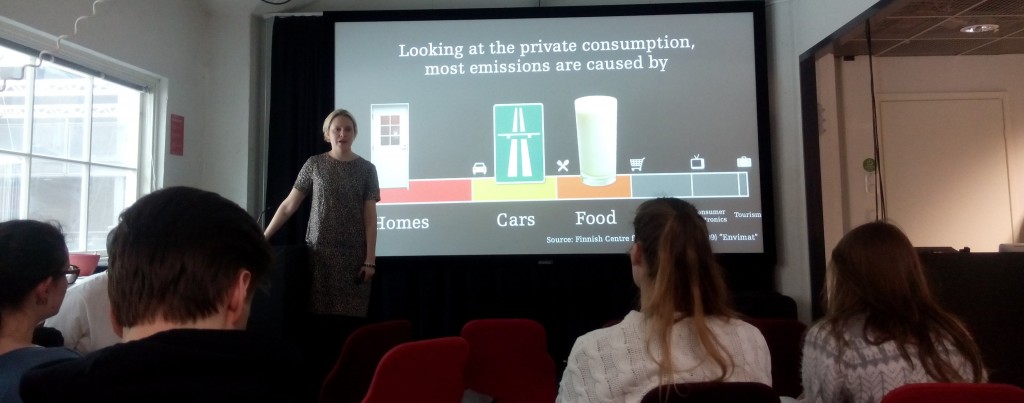
What is up next for our team?
The mid-term review is just around the corner! We will present our hitherto progress to our client and other stakeholders to get valuable feedback and guidance on how to proceed and what we should focus thereafter. The two Project Piazza teams are busy organising a workshop for the potential users of the service to gain more insights on what is actually needed and to test and try out some of our ideas. After the mid-term, we will divide the supergroup into two, and work more independently to create two different solutions.
Thanks for reading, and stay tuned!
